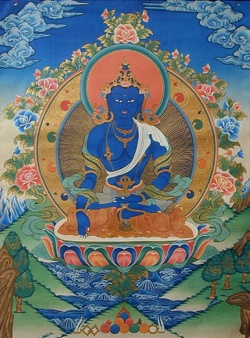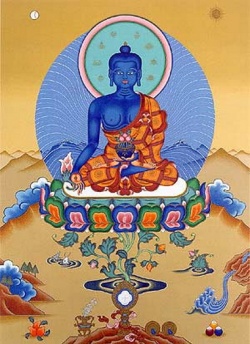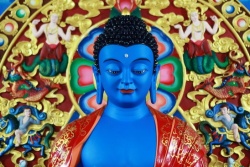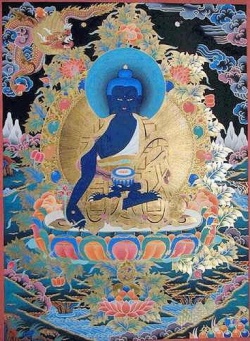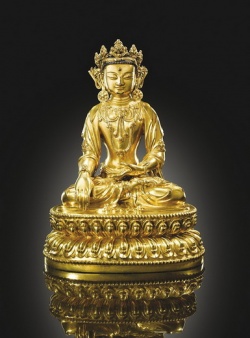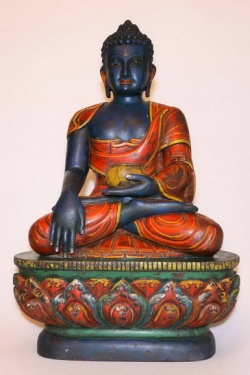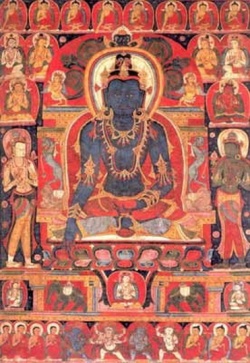Aksobhya
- See also :
- See also :
The name Akshobhya (Aksobhya) means " Immovable " or " Unshakable."
In Chinese he is called Ah-Chu-For.
In Japanese he is called Ashuku Nyorai.
In Tibetan he is called Mi Kyu Pa, or Sang Gye.
He is a principal Buddha within Vajrayana Buddhism residing in the eastern quarter of a Mandala, surrounded by numerous forms of Green and White Tara. He is found throughout all four Tantra classifications most notably in the Anu-yoga class. His consort is Lochana, and they represent the Tathagata family, space and all encompassing Wisdom. Akshobhya is also mentioned in several Mahayana Sutras, the Vimalakirti Nirdesa being the most famous.
Akshobhya symbolizes the overcoming of passions. This Buddha originates from the blue Mantra "Hum" and reigns over the eastern paradise - Abhirati, the Land of Exceeding Great Delight. It is believed that whoever is reborn there can never fall back to a lower level of Consciousness, thus all believers should seek to fulfill the promise kept by Akshobhya. Akshobhya's Bija is Hum and his Mantra is Om Akshobhya Hum.
Akshobhya as a Monk is said to have taken a vow before The Buddha who, endlessly long ago, reigned over Abhirati, never to feel disgust or Anger towards any being. In carrying out this vow, he showed himself "immovable" and after endlessly long striving became Buddha Akshobhya and thereby the ruler of the Abhirati paradise. According to the Sutras,"He arising in the eastern direction on an elephant, Lotus and moon throne; with a Body blue in color and the right hand is placed in the bhumisparsha (earth-touching) Mudra." This Mudra with the fingers pressing against the ground represents the enlightenment commitment by calling the earth to commemorate Sakyamuni Buddha's victory over temptation by the Evil One, Mara. Akshobhya's left hand placed palm upward in the lap performs the Mudra of Meditation.
Akshobhya rules over the element of water and personifies the Skandha of Form. In some systems, he is associated with the Skandha of Consciousness. His Lotus throne is supported by the elephant, which represents steadfastness and strength. His Symbol is the Vajra, which denotes Enlightenment, the indestructible, adamantine nature of pure Consciousness, or the essence of Reality. In some traditions the Vajra signifies the union of man and The Buddha; one end of the Vajra symbolizes the macrocosmic realm (The Buddha) and the other end the microcosmic realm (man).
Akshobhya is the second of the Transcendental Buddhas. Akshobhya originates from the blue seed syllable HUM and represents the primordial cosmic element of consciousness; immutable and imperturbable. The path to enlightenment through the Vajra family is one of breaking free of constraints and obstacles, transmuting negativity, and is generally more dynamic and proactive.
Akshobhya is believed to transform the human failing of anger into a clear mirror-like wisdom. With this wisdom, we see things just as they are, impartially and unaffectedly. Indeed, whether it is a red rose or a bloody dagger, a mirror will reflect both just as they are. It will not be judgmental and distinguish between the two reds, attempting to hold to the first and flee from the second. No reflection in a mirror sticks to it, and none repels it. The mirror always stands imperturbable and immutable, just as we should, whether the circumstances are favorable or unfavorable to us.
Akshobhya is blue in blue in color and his blue color is closely linked to the mirror symbolism. Blue is the color of water, and water has the capacity to act as a clear mirror. Akshobhya makes the Bhumisparsha Mudra (Earth Touching Gesture). This gesture recalls the incident just before Buddha’s enlightenment when he was challenged by Mara, the personification of evil. Mara was convinced that the spiritual throne where Buddha was sitting belonged rightly to him. Accordingly he challenged Buddha to prove his claim to the seat. Buddha moved his hand to touch the ground with his fingertips, and thus bid the goddess Earth to bear witness to his right to be sitting where he was. She did so with a hundred thousand roars, and validated Buddha’s assertion. Akshobhya’s emblem is the Vajra. The Vajra is the quintessential symbol of Vajrayana Buddhism, which derives its name from the Vajra itself. The Sanskrit term Vajra means 'the hard or mighty one', and its Tibetan equivalent Dorje means an indestructible hardness and brilliance like the diamond, which cannot be cut or broken. The Vajra essentially signifies the immovable, immutable, indivisible, and indestructible state of enlightenment. Thus is Akshobhya touching the earth with the fingertips of his right hand, the earth too being a symbol of the immutable, the solid, and the concrete. Akshobhya’s mount is the elephant. An elephant places its foot upon the earth with unshakeable certainty. It has the same unalterable quality as the Buddha’s fingers touching the ground, and the same determination that carried Buddha through his tribulations.
Akshobhya is often depicted with his consort Lochana who expresses the mirror-like primordial wisdom. Akshobhya is considered the ruler over the eastern direction. It is the direction where dawn takes place. Indeed, Buddha’s victory over Mara heralded the dawning of a new, spiritual reality.
Akshobhya Buddha (Sanskrit: अक्षोभ्य, Akṣobhya, "Immovable One"; Tib. Mikyopa) in Tibetan Buddhism is considered one of the five Dhyani Buddhas, the ultimate emanations of the one absolute Buddha nature that pervades everything. Alike the other Dhyani Buddha Amitabha, Akshobhya also has his own Buddha-field in the East, called the Pure Land Abhirati ('The Ultimate Joy').
According to the “Sutra of the Buddha-land of Akshobhya” (Akṣobhyavyūha Sutra), many aeons ago a monk gave strong vows to practice and teach Dharma in the Eastern Land and not feel any anger or malice towards any sentient being until enlightenment. He proved to be unshakable in his determination and became Buddha Akshobhya. In the Akshobhya Sutra, the Buddha Shakyamuni himself extolled the patience of Akshobhya in actualizing his intention so powerfully that countless beings have been saved from the intense suffering of lower states of existence. Akshobhya is usually depicted in blue colour, symbolising the colour of clear water that reflects things as they are. Akshobhya symbolises a clear mirror-like wisdom, which can transform any anger and clean stiff feelings. No reflection in a mirror sticks to it, and none repels it. The mirror always stands imperturbable and immutable, just as we should, whether the circumstances are favourable or unfavourable to us. Akshobhya is doing earth-touching gesture (Bhumisparsha mudra)with the fingertips of his right hand. This gesture suggests confidence, deep-rootedness and determination. In his left he holds Dorje on his lap. Buddha Akshobhya may be together with his consort Lochanā and usually is accompanied by two elephants. As an elephant places its foot upon the earth with unshakeable certainty, so the Buddha Akshobhya mind reflects everything.
Buddha Akshobhya mantra is considered an effective remedy for purifying ones negative karma, somewhat similar to Dorje Sempa mantra. But the mantra of Dorje Sempa is more intended for purifying negativities related to Vajrayana practices, especially broken samayas, the tantric vows. Whereas Buddha Akshobhya mantra is very powerful for cleaning the general negative karma, and thus is very beneficial even for non-Vajrayana practitioners.
Akshobhya is the embodiment of 'mirror-like knowledge' (Sanskrit: ādarśa-jñāna;). Knowledge of what is real, and what is illusion, or a mere reflection of actual reality. The mirror is mind itself - clear like the sky, empty but luminous. Comprising all the images of space and time, yet untouched by them. Akshobhya represents the absolute Buddha Mind, and the Vajra family to which he belong is connected with reason and intellect. Its brilliance illuminates the darkness of ignorance and its sharpness cuts through confusion.
Tibetan Book of the Dead (Bardo Thodol) mentions Buddha Akshobhya is manifesting himself to the dead in after-death state (Bardo) on a second day, after the Buddha Vairochana. Bardo Thodol says the following: “On the second day will shine a white light of a completely purified element of Water. Then from the pure blue dimension of Ultimate Joy in the East the blissful Buddha Akshobhya will appear. His body is blue and five-pointed Vajra in his hands. He is seated on an elephant throne and his wife Buddha-Lochana is with him. He is accompanied by two bodhisattvas Kshitigarbha and Maitreya, and the two Bodhisattvas, Lasya and Pushpa. Thus, only in this light will shine six forms of Buddhas. The white light of the skandha of forms (rupa-skandha in Sanskrit) in its pure dimension is the Mirror-Like Wisdom, white and shining, clear and transparent – will radiate towards you from the heart of Buddha Akshobhya and his consort…”
Here Akshobhya is associated with rupa-skandha and in his hands he is holding vajra (dorje) and the bell. When the Bardo of peaceful deities ends and begins Bardo of wrathful deities, Akshobhya-Buddha appears as Vajra Heruka. At this moment it is important to be not scared and to recognize his ultimate Buddha nature and wisdom.
Akshobhya, the Immutable; one of the five Buddhas (rgyal ba rigs lnga), lord of the Vajra Family; his sambhogakaya form is Vajrasattva
ma ma ki - Mamaki, [Syn {rdo rje ma ma ki} female buddha, consort of Akshobhya).
Akshobhya, The Mirror to Our Souls (Tib. Mikyopa): One of The Five Meditating Buddhas According to the Tibetan Dhammapada: Those who control their wrath when it rears up As they would a horse when it strays loose, I call the best trainers, those who do not, are common beings.
Akshobhya is believed to transform the human failing of anger into a clear mirror like wisdom. With this wisdom, we see things just as they are, impartially and unaffectedly. Indeed, whether it be a red rose or a bloody dagger, a mirror will reflect both just as they are. It will not be judgmental and distinguish between the two reds, attempting to hold to the first and flee from the second. No reflection in a mirror sticks to it, and none repels it. The mirror always stands imperturbable and immutable, just as we should, whether the circumstances be favorable or unfavorable to us.
Akshobhyas blue color is closely linked to the mirror symbolism. Blue is the color of water, and water has the capacity to act as a clear mirror. He makes the Bhumisparsha mudra (earth touching gesture). This gesture recalls the incident just before Buddha s enlightenment when he was challenged by Mara, the personification of evil.
Mara was convinced that the spiritual throne where Buddha was sitting belonged rightly to him. Accordingly he challenged Buddha to prove his claim to the seat. Buddha moved his hand to touch the ground with his fingertips, and thus bid the goddess Earth to bear witness to his right to be sitting where he was. She did so with a hundred thousand roars, and validated Buddha s assertion. More relevant to our interest here is the fact that this gesture suggests confidence, deep rootedness, and the same kind of determination which carried the Buddha to his enlightenment, inspite of the numerous hurdles which crossed his path.
Akshobhyas emblem is the vajra. The Vajra is the quintessential symbol of Vajrayana Buddhism, which derives its name from the vajra itself. The Sanskrit term vajra means the hard or mighty one, and its Tibetan equivalent dorje means an indestructible hardness and brilliance like the diamond, which cannot be cut or broken. The vajra essentially signifies the immovable, immutable, indivisible, and indestructible state of enlightenment.
Thus is Akshobhya touching the earth with the fingertips of his right hand, the earth too being a symbol of the immutable, the solid, and the concrete. Akshobhya s mount is the elephant. An elephant places its foot upon the earth with unshakeable certainty. It has the same unalterable quality as the Buddha s fingers touching the ground, and the same determination that carried Buddha through his tribulations. Akshobhya is considered the ruler over the eastern direction. It is the direction where dawn takes place. Indeed, Buddha s victory over Mara heralded the dawning of a new, spiritual reality.
In Vajrayana Buddhism, Akshobhya (Sanskrit for "Immovable One") (Japanese for Ashuku nyorai; Chinese achurulai; Mongolian for Kodelusi ugei) is one of the Five Wisdom Buddhas, a product of the Adibuddha, who represents consciousness as an aspect of reality. By convention he is located in the east of the Diamond Realm and is the lord of the Eastern Pure Land Abhirati (The Joyous), although the Pure Land of Akshobhyas western counterpart Amitabha is far better known. His consort is Locana and he is normally accompanied by two elephants. His color is blue and his attributes include the belle robes, and staff, along with a jewel, lotus, prayer wheel, and sword. He has several emanations.
Akshobhya appears in the "Scripture of the Buddha land of Akshobhya" (achufo guo jing), which dates from 147 AD and is the oldest known Pure Land text. According to the scripture, a monk wished to practice the Dharma in the eastern world of delight and made a vow to think no anger or malice towards any being until enlightenment. He duly proved "immovable" and when he succeeded, he became the buddha Akshobhya.
Akshobhya is sometimes merged with Acala (Japanese: Fudo myo o), whose name also means immovable one in Sanskrit. However, Acala is not a buddha, but one of the Five Wisdom Kings of the Womb Realm in Vajrayana.
Prior to the advent of Bhaisajyaguru (Yakushi), Akshobhya was the subject of a minor cult in Japan as a healing buddha, though even now both are found within the Shingon school of Buddhism in Japan.
Recently, newly discovered Gandhari texts from Pakistan in the Bajaur Collection has been found to contain fragments of an early Mahayan sutra mentioning Aksobhya. Preliminary dating through paleography suggests a late first century to early second century AD provenance. More conclusive radiocarbon dating is underway. A complete analysis and report of the text is expected in late 2008.
Earliest of the non historical celestial Buddhas who is believed to govern the Eastern Paradise also known as the Abhirati. He is mostly represented in dark blue or sometimes even golden colour. He has a vajra or a diamond sceptre in his right hand and makes the earth touching gesture from his left. He is usually shown seated on a blue elephant. Aksobhaya is well known in Nepal and Tibet.
The seed mantra of Akshobhya is syllable HUNG. The long version of Akshobhya mantra to purify all negative karma is:
Namo Ratna Trayaya
Om Kamkani Kamkani
Rotsani Rotsani
Trotrani Trotrani
Trasani Trasani
Pratihana Pratihana
Sarva Karma Param Para Nime Sarva Sato Nantsa Svaha
Namo bhagavate Akṣhobhāya, tathāgatāyārhate saṃyaksaṃbuddhyāya. Tadyathā:
Oṃ kaṃkani kaṃkani. Rotsani rotsani. Troṭani troṭani. Trāsani trāsani. Pratihana pratihana. Sarva karma paraṃparāṇime sarva Sato Nantsa svāhā.
See also:Akshobhya
